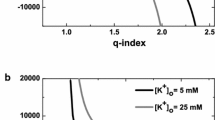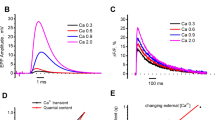Abstract
The timing of transmitter release from nerve endings is considered nowadays as one of the factors determining the plasticity and efficacy of synaptic transmission. In the neuromuscular junction, the moments of release of individual acetylcholine quanta are related to the synaptic delays of uniquantal endplate currents recorded under conditions of lowered extracellular calcium. Using Bayesian modelling, we performed a statistical analysis of synaptic delays in mouse neuromuscular junction with different patterns of rhythmic nerve stimulation and when the entry of calcium ions into the nerve terminal was modified. We have obtained a statistical model of the release timing which is represented as the summation of two independent statistical distributions. The first of these is the exponentially modified Gaussian distribution. The mixture of normal and exponential components in this distribution can be interpreted as a two-stage mechanism of early and late periods of phasic synchronous secretion. The parameters of this distribution depend on both the stimulation frequency of the motor nerve and the calcium ions’ entry conditions. The second distribution was modelled as quasi-uniform, with parameters independent of nerve stimulation frequency and calcium entry. Two different probability density functions for the distribution of synaptic delays suggest at least two independent processes controlling the time course of secretion, one of them potentially involving two stages. The relative contribution of these processes to the total number of mediator quanta released depends differently on the motor nerve stimulation pattern and on calcium ion entry into nerve endings.






Similar content being viewed by others
Abbreviations
- TCS:
-
Time course of secretion
- EPC:
-
Endplate current
- EMG:
-
Exponentially modified Gaussian
- [Са2+]out :
-
Extracellular calcium concentration
- [Mg2+]out :
-
Extracellular magnesium concentration
- 4-AP:
-
4-aminopyridine
- QU:
-
Quasi-uniform process
References
Atluri, P. P., & Regehr, W. G. (1998). Delayed release of neurotransmitter from cerebellar granule cells. Journal of Neuroscience, 18(20), 8214–8227.
Augustine, G. J. (2003). How does calcium trigger neurotransmitter release? Current Opinion in Neurobiology, 11(3), 320–326.
Barrett, E. F., & Stevens, C. F. (1972). The kinetics of transmitter release at the frog neuromuscular junction. Journal of Physiology, 227, 691–708.
Bennett, M. R., & Kearns, J. L. (2000). Statistics of transmitter release at nerve terminals. Progress in Neurobiology, 60(6), 545–606.
Bennett, M. R., Gibson, W. G., & Robinson, J. (1997). Probabilistic secretion of quanta and the synaptosecretosome hypothesis: evoked release at active zones of varicosities, boutons, and endplates. Biophysical Journal, 73(4), 1815–1829.
Bukharaeva, E., Samigullin, D., Nikolsky, E., & Vyskocil, F. (2002). Protein kinase A cascade regulates quantal release dispersion at frog muscle endplate. Journal of Physiology, 538, 837–848.
Bukharaeva, E. A., Samigullin, D. V., Nikolsky, E. E., & Magazanik, L. G. (2007). Modulation of the kinetics of evoked quantal release at mouse neuromuscular junctions by calcium and strontium. Journal of Neurochemistry, 100, 939–949.
Bukсharaeva, Е., Kim, K., Moravec, J., Nikolsky, E., & Vyskočil, F. (1999). Noradrenaline synchronizes evoked quantal release at frog neuromuscular junctions. Journal of Physiology, 517, 879–888.
Chang, C. Y., & Mennerick, S. (2010). Dynamic modulation of phasic and asynchronous glutamate release in hippocampal synapses. Journal of Neurophysiology, 103, 392–401.
Chen, C., & Regher, W. (1999). Contributions of residual calcium to fast synaptic transmission. Journal of Neuroscience, 19, 6257–6266.
Chung, C., & Raingo, J. (2013). Vesicle dynamics: how synaptic proteins regulate different modes of neurotransmission. Journal of Neurochemistry, 126(2), 146–154. doi:10.1111/jnc.12245.
Delaney, K. R., & Tank, D. W. (1994). A quantitative measurement of the dependence of short-term synaptic enhancement on presynaptic residual calcium. Journal of Neuroscience, 14(10), 5885–5902.
Delcour, A. H., Lipscombe, D., & Tsien, R. W. (1993). Multiple modes of N-type calcium channel activity distinguished by differences in gating kinetics. Journal of Neuroscience, 13(1), 181–194.
Dodge, F., & Rahamimoff, R. (1967). Cooperative action of calcium ions in transmitter release at the neuromuscular junctions. Journal of Physiology, 193, 419–432.
Dudel, J. (2009). Depolarization amplitude and Ca2+-inflow control the time course of quantal releases at murine motor nerve terminals. Europen Journal of Neuroscience, 30(7), 1219–1226. doi:10.1111/j.1460-9568.2009.06915.x.
Dudel, J., Parnas, H., & Parnas, I. (1991). Evoked phasic release in frog nerve terminals obtained after block of Ca2+ entry by Cd2+. Pflügers Archiv, 419(2), 197–204.
Feldchyshyn, M. J., & Wang, L. Y. (2007). Activity-dependent changes in temporal components of neurotransmission at the juvenile mouse calyx of Held synapse. Journal of Physiology, 581, 581–602.
Fesce, R. (1999). The kinetics of nerve-evoked quantal secretion. Philosophical Transactions of the Royal Society, B: Biological Sciences, 354, 319–329.
Gainulov, R., Bukharaeva, E., & Nikolskii, E. (2002). A method for assessing the kinetics of evoked secretion of transmitter quanta determining the generation of multiquantum endplate currents. Neuroscience Behavioral Physiology, 32(6), 613–616.
Gelman, A., & Rubin, D. B. (1992). Inference from iterative simulation using multiple sequences. Statistical Science, 7, 457–511.
Gelman, A., Carlin, J. B., Stern, H. S., Dunson, D. B., Vehtari, A., & Rubin, D. B. (2014). Bayesian data analysis. Boca Raton: CRC Press.
Gilmanov, I., Samigullin, D., Vyskocil, F., Nikolsky, E., & Bukharaeva, E. (2008). Modeling of quantal neurotransmitter release kinetics in the presence of fixed and mobile calcium buffers. Journal of Computational Neuroscience, 25, 296–307.
Goda, Y., & Stevens, C. F. (1994). Two components of transmitter release at a central synapse. Proceedings of the National Academy of Sciences, 91, 12942–12946.
Hagler, D. J., & Goda, Y. (2001). Properties of synchronous and asynchronous release during pulse train depression in cultured hippocampal neurons. Journal of Neurophysiology, 85(6), 2324–2334.
Hefft, S., & Jonas, P. (2005). Asynchronous GABA release generates long-lasting inhibition at a hippocampal interneuron-principal neuron synapse. Nature Neuroscience, 8(10), 1319–1328.
Kaeser, P. S., & Regehr, W. G. (2014). Molecular mechanisms for synchronous, asynchronous, and spontaneous neurotransmitter release. Annual Review of Physiology, 2014(76), 333–363.
Katz, B. (1996). Neural transmitter release: from quantal secretion to exocytosis and beyond. The Fenn Lecture. Journal of Neurocytology, 25, 677–686.
Katz, B., & Miledi, R. (1965). The measurement of synaptic delay and the time course of acetylcholine release at the neuromuscular junction. Proceedings of the Royal Society B: Biological Sciences, 161, 483–495.
Khuzakhmetova, V., Samigullin, D., Nurullin, L., Vyskocil, F., Nikolsky, E., & Bukharaeva, E. (2014). Kinetics of neurotransmitter release in neuromuscular synapses of newborn and adult rats. International Journal of Developmental Neuroscience, 34, 9–18.
Lin, J.-W., & Farber, S. (2002). Modulation of synaptic delay during synaptic plasticity. Trends in Neurosciences, 25, 449–455.
Lu, T., & Trussel, L. O. (2000). Inhibitory transmission mediated by asynchronous transmitter release. Neuron, 26(3), 683–694.
Matzke, D., Dolan, C. V., Logan, G. D., Brown, S. D., & Wagenmakers, E. J. (2013). Bayesian parametric estimation of stop-signal reaction time distributions. Journal of Experimental Psychology: General, 142(4), 1047–1073. doi:10.3389/fpsyg.2013.00918.
Minneci, F., Kanichay, R. T., & Silver, R. A. (2012). Estimation of the time course of neurotransmitter release at central synapses from the first latency of postsynaptic currents. Journal of Neuroscience Methods, 205(1), 49–64. doi:10.1016/j.jneumeth.2011.12.015.
Muller, D. (1986). Potentiation by 4-aminopyridine of quantal acetylcholine release at the torpedo nerve-electroplaque junction. Journal of Physiology, 379, 479–493.
Neff, R. A., Conroy, W. G., Schoellerman, J. D., & Berg, D. K. (2009). Synchronous and asynchronous transmitter release at nicotinic synapses are differentially regulated by postsynaptic PSD-95 proteins. Journal of Neuroscience, 29(50), 15770–15779.
Neher, E., & Sakaba, T. (2008). Multiple roles of calcium ions in the regulation of neurotransmitter release. Neuron, 59, 861–872.
Nikolsky, E. E., Vyskocil, F., Bukharaeva, E. A., Samigullin, D. V., & Magazanik, L. G. (2004). Cholinergic regulation of the evoked quantal release at frog neuromuscular junction. Journal of Physiology, 560, 77–88.
Otsu, Y., Shahrezaei, V., Li, B., Raymond, L., Delaney, K., & Murphy, T. (2004). Competition between phasic and asynchronous release for recovered synaptic vesicles at developing hippocampal autaptic synapses. Journal of Neuroscience, 24, 420–433.
Pan, B., & Zucker, R. S. (2009). A general model of synaptic transmission and short-term plasticity. Neuron, 62(4), 539–554. doi:10.1016/j.neuron.2009.03.025.
Pang, Z. P., & Sudhof, T. C. (2010). Cell biology of Ca2 + -triggered exocytosis. Current Opinion in Cell Biology, 22, 496–505. doi:10.1016/j.ceb.2010.05.001.
Parnas, I., & Parnas, H. (2010). Control of neurotransmitter release: from Ca2+ to voltage dependent G-protein coupled receptors. Pflugers Archiv / Europen Journal Physiology, 460, 975–990.
Plummer, M. (2012). Rjags: Bayesian graphical models using MCMC. R packageversion 3-9. http://CRAN.R-project.org/package=rjags.
Rahamimoff, R., & Yaari, Y. (1973). Delayed release of transmitter at the frog neuromuscular junction. Journal of Physiology, 228, 241–257.
Sabatini, B., & Regehr, W. (1999). Timing of synaptic transmission. Annual Review of Physiology, 61, 521–542.
Smith, S., Chen, W., Vyleta, N., Williams, C., Lee, C.-H., Phillips, C., & Andresen, M. (2012). Calcium regulation of spontaneous and asynchronous neurotransmitter release. Cell Calcium, 52, 226–233. doi:10.1016/j.ceca.2012.06.001.
Stevens, C. F. (1968). Synaptic physiology. Proceedings of the IEEE, 56, 916–930.
Su, Y-S., & Yajima, M. (2012). R2jags: a package for running jags from R. R package version 0.03–08. http://CRAN.R-project.org/package=R2jags.
Tarr, T. B., Dittrich, M., & Meriney, S. D. (2013). Are unreliable release mechanisms conserved from NMJ to CNS? Trends in Neuroscience, 36, 14–22. doi:10.1016/j.tins.2012.09.009.
Van der Kloot, W. (1988a). Estimating the timing of quantal releases during end-plate currents at the frog neuromuscular junction. Journal of Physiology, 402, 595–603.
Van der Kloot, W. (1988b). The kinetics of quantal releases during end-plate currents at the frog neuromuscular junction. Journal of Physiology, 402, 605–626.
Vyshedskiy, A., & Lin, J. W. (2000). Presynaptic Ca(2+) influx at the inhibitor of the crayfish neuromuscular junction: a photometric study at a high time resolution. Journal of Neurophysiology, 83(1), 552–562.
Wen, H., Hubbard, J. M., Rakela, B., Linhoff, M. W., Mandel, G., & Brehm, P. (2013). Synchronous and asynchronous modes of synaptic transmission utilize different calcium sources. Elife, 2, e01206. doi:10.7554/eLife.01206.
Acknowledgments
Supported by the Russian Government’s Program for Competitive Growth of Kazan Federal University and was also supported by a grant of President of Russian Federation “Leading Scientific School” and a grants from the Russian Foundation for Basic Research (13-04-00886 for DS; 14-04-00987 for IK and EN, 14-04-00790 for AS, 15-04-02983 for VKh and EB).
Conflict of interest
The authors declare that they have no conflict of interest.
Author information
Authors and Affiliations
Corresponding author
Additional information
Action Editor: Catherine E. Carr
Rights and permissions
About this article
Cite this article
Saveliev, A., Khuzakhmetova, V., Samigullin, D. et al. Bayesian analysis of the kinetics of quantal transmitter secretion at the neuromuscular junction. J Comput Neurosci 39, 119–129 (2015). https://doi.org/10.1007/s10827-015-0567-3
Received:
Revised:
Accepted:
Published:
Issue Date:
DOI: https://doi.org/10.1007/s10827-015-0567-3




